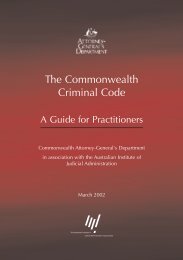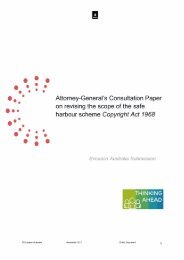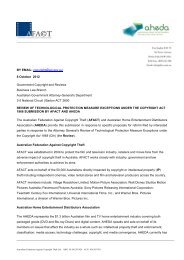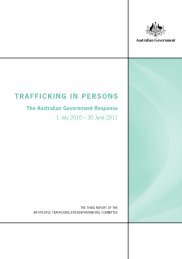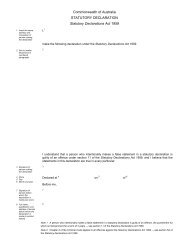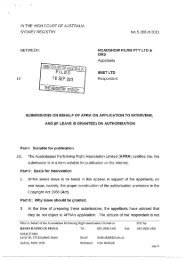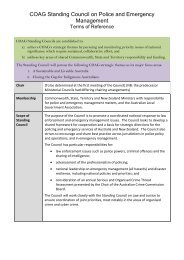Normann Witzleb [PDF 657KB] - Attorney-General's Department
Normann Witzleb [PDF 657KB] - Attorney-General's Department
Normann Witzleb [PDF 657KB] - Attorney-General's Department
You also want an ePaper? Increase the reach of your titles
YUMPU automatically turns print PDFs into web optimized ePapers that Google loves.
discretion to grant the remedy that is most appropriate in the circumstances. 126 The<br />
latter two proposals recommend that the legislation contain a non-exhaustive list of the<br />
most common orders, but that the court can also fashion other relief. In addition, both<br />
proposals envisage that the court’s discretion in relation to remedies should not be<br />
limited by jurisdictional restraints that may apply at general law. 127<br />
77 The ALRC and the NSW proposals vary in relation to the orders that have been<br />
included in the non-exhaustive list. The NSW proposes that a court may grant any one or<br />
more of the following remedies:<br />
<br />
<br />
<br />
<br />
compensatory damages;<br />
prohibitive injunctions;<br />
declarations;<br />
delivery up; and<br />
‘such other relief as the court considers necessary in the circumstances’. 128<br />
78 Beyond this, the ALRC also specifically refers to an account of profit, an order<br />
requiring the defendant to apologise to the plaintiff and a correction order. 129<br />
79 None of the proposals support the availability of exemplary damages. 130<br />
Comment<br />
80 Allowing remedial flexibility was one of the reasons why the ALRC and the NSWLRC<br />
preferred a statutory cause of action over judicial development of the law or the<br />
enactment of a statutory privacy tort. 131 Australian courts have proven in the context of<br />
other major statutes 132 that they are able to apply extremely broad remedial provisions<br />
with sensitivity and fairness. The High Court has emphasised repeatedly that, in<br />
fashioning the appropriate relief under statute, the primary task will be ‘construing the<br />
relevant provisions of the Act’ rather than attempting to draw an analogy with remedial<br />
principles of general law. 133 Where the plaintiff applies for a statutory injunction, the<br />
court will thus take into account whether the injunction would have some utility or would<br />
126 ALRC Report, Rec 74-5.<br />
127 Ibid, Rec 74-5; NSWLRC Report, at [7.2].<br />
128 NSW Draft Bill, cl 76(2).<br />
129 ALRC Report, Rec 74-5.<br />
130 Ibid, Rec 74-5; NSW Draft Bill, cl 78; VLRC Report, at [7.218]<br />
131 New South Wales Law Reform Commission, Invasion of Privacy, Consultation Paper 1, 2007, at [1.5]-<br />
[1.8], Australian Law Reform Commission, Review of Australian Privacy Law, Discussion Paper 72, 2006,<br />
[5.69]-[5.70].<br />
132 For example, s 232 of the Australian Consumer Law (ACL) and s 1324 of the Corporations Act 2001<br />
(Cth) give the court an unfettered discretion to grant an injunction where a person has engaged, or is<br />
proposing to engage, in a contravention of specified provisions of the ACL or the Corporations Act,<br />
respectively.<br />
133 See Marks v GIO Australia Holdings Ltd (1998) 196 CLR 494; [1998] HCA 69; Murphy v Overton<br />
Investments Pty Ltd (2004) 216 CLR 388 [2004] HCA 3, (both in relation to the remedies in Part VI of the<br />
Trade Practices Act 1974 (Cth), which are now largely contained in the Australian Consumer Law set out<br />
in Schedule 2 of the Competition and Consumer Act 2010 (Cth)).<br />
27


![Normann Witzleb [PDF 657KB] - Attorney-General's Department](https://img.yumpu.com/26247895/27/500x640/normann-witzleb-pdf-657kb-attorney-generals-department.jpg)

